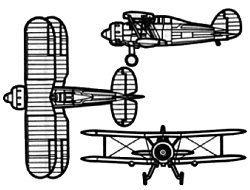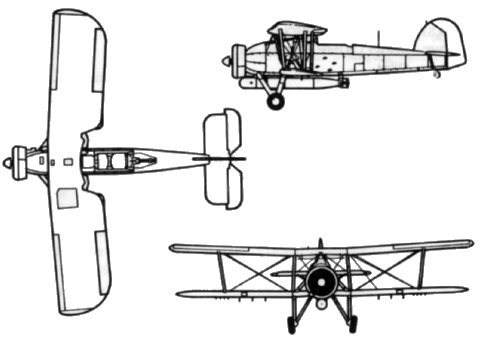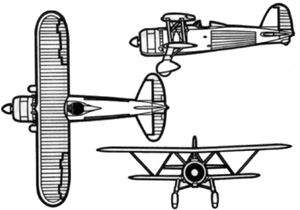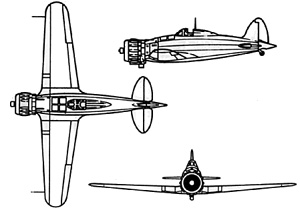Author's Note: I'm always looking for excuses to do new and interesting aircraft for the FW game system. When Steve Rawling called me up in January and said I could have some room to publish some aircraft in the COA newsletter, I took up the offer. At first I thought I'd do something on the Polish Air Force but instead of more European stuff, opted for the Mediterranean. The release of the Command At Sea (CAS) module Supermarina 1. with its superb set of aircraft counters, gave me just such an excuse. I decided to take advantage of the Supermarina I countersheet 1 All those early war British planes, and of course, the Italians intrigue me quite a bit, so, Of course, I now had to decide which to do and with so many counters to choose from that wasn't easy. I looked at doing a random draw, and other methods, but, in the end I decided to do the following four as they are simply just some of my favorite aircraft.
Historical Background
Aircraft Briefings
 Gloster Gladiator: The Gladiator was the last of a long line of superb British biplane fighter designs. Though the Hurricane and Spitfire prototypes were already flying when the
Gladiator entered service, the British, in desperate need of fighter aircraft due to the
looming threat of WWII and due the rapid expansion of the RAF in 1938, ended up having
13 of 35 fighter squadrons still equipped with Gladiators at the start of the war. A state-of-
the-art aircraft when designed in 1936, the Gladiator offered good top speed performance
for its day, a radio, blind-flying instruments, an enclosed cockpit, and a pack of four fast
firing .303 machine guns. This was twice the firepower of the typical biplane fighters
that had proceeded it and sufficient to deal with the lightly built aircraft threats of the
1930's. Highly maneuverable, the Gladiator gave a good account of itself in many different theaters before being retired quickly from the front lines. Like all biplanes, it was
eclipsed early in the war, by stronger, faster, more powerful and heavily armed monoplane
fighters. However, one of its principal opponents in the Mediterranean theater and in Africa was the Italian Fiat C.R.42 Falco, a superb biplane fighter in itself. Battles between formations of these two aircraft became vicious close-in dogfights every bit as exciting as those of the by-gone glory days of WWI aerial combat.
Gloster Gladiator: The Gladiator was the last of a long line of superb British biplane fighter designs. Though the Hurricane and Spitfire prototypes were already flying when the
Gladiator entered service, the British, in desperate need of fighter aircraft due to the
looming threat of WWII and due the rapid expansion of the RAF in 1938, ended up having
13 of 35 fighter squadrons still equipped with Gladiators at the start of the war. A state-of-
the-art aircraft when designed in 1936, the Gladiator offered good top speed performance
for its day, a radio, blind-flying instruments, an enclosed cockpit, and a pack of four fast
firing .303 machine guns. This was twice the firepower of the typical biplane fighters
that had proceeded it and sufficient to deal with the lightly built aircraft threats of the
1930's. Highly maneuverable, the Gladiator gave a good account of itself in many different theaters before being retired quickly from the front lines. Like all biplanes, it was
eclipsed early in the war, by stronger, faster, more powerful and heavily armed monoplane
fighters. However, one of its principal opponents in the Mediterranean theater and in Africa was the Italian Fiat C.R.42 Falco, a superb biplane fighter in itself. Battles between formations of these two aircraft became vicious close-in dogfights every bit as exciting as those of the by-gone glory days of WWI aerial combat.
 Fairy Swordfish: For whatever reason, this ungainly, slow, and vulnerable biplane seems to pique every air historian and gamer's fancy. Perhaps it is the image of the gallant,
but suicidal attack, in the face German fighter cover, of six Swordfish, led by Lt. Commander Esmonde, at the German battlecruisers Gneisenau and Scharnhorst during their famous 1942 channel dash. Or, maybe, it is the fact that this anachronism of a warplane truly proved to be one of the great workhorses of WWII, flying in every theater, and earning such distinctions as, becoming the devastator of the Italian battle-fleet in Taranto harbor, and the crippler of the Bismarck's steering gear which doomed that great German battleship to its death at the hands of the British fleet shortly thereafter. At the start of the war, the Fleet Air Arm had thirteen
Swordfish squadrons on hand. This eventually grew to 26 squadrons, of which nine were still active at the end of the war.
Fairy Swordfish: For whatever reason, this ungainly, slow, and vulnerable biplane seems to pique every air historian and gamer's fancy. Perhaps it is the image of the gallant,
but suicidal attack, in the face German fighter cover, of six Swordfish, led by Lt. Commander Esmonde, at the German battlecruisers Gneisenau and Scharnhorst during their famous 1942 channel dash. Or, maybe, it is the fact that this anachronism of a warplane truly proved to be one of the great workhorses of WWII, flying in every theater, and earning such distinctions as, becoming the devastator of the Italian battle-fleet in Taranto harbor, and the crippler of the Bismarck's steering gear which doomed that great German battleship to its death at the hands of the British fleet shortly thereafter. At the start of the war, the Fleet Air Arm had thirteen
Swordfish squadrons on hand. This eventually grew to 26 squadrons, of which nine were still active at the end of the war.
Is this the stuff of legends? No, but it is still a remarkable career. The truth is, against modem aircraft, it was nearly helpless, and it suffered high losses when it ran afoul of defending fighters despite its maneuverability. By the end of 1941, the Swordfish had been replaced in front line service by more modern types. Nevertheless, they continued to serve for the rest of the conflict in a number of difficult missions, including, but not limited to: convoy anti-sub patrols; mine-laying; long range search; and as a rocket-armed anti-shipping aircraft for Coastal Command. Its utility and adaptability to these back-water missions is what kept it around long past its time and much to the chagrin of its crews whom, still riding around in open cockpits, must certainly have been longing for something better to fly.
 Fiat C.R.42 Falco: The Falco, like the British Gladiator that predated it a year, was a bi-plane fighter, technically obsolete at the start of the WWII, but superb in concept and design. The Falco can easily be regarded as the world's most advanced and carefully designed
biplane ever. The Italians, caught in the classic mental trap of designing a weapon to win
the "last" war instead of the "next" war made the Falco into one of the fastest and most maneuverable biplanes ever.
Fiat C.R.42 Falco: The Falco, like the British Gladiator that predated it a year, was a bi-plane fighter, technically obsolete at the start of the WWII, but superb in concept and design. The Falco can easily be regarded as the world's most advanced and carefully designed
biplane ever. The Italians, caught in the classic mental trap of designing a weapon to win
the "last" war instead of the "next" war made the Falco into one of the fastest and most maneuverable biplanes ever.
If the Gladiator was a solid and logical example of biplane fighter design, the Falco was, by comparison, a brilliant work of art. It utilized advanced construction techniques and was incredibly sturdy. It had ample power, and every effort was made to keep it aerodynamically clean. It even featured a modern gunsight and constant speed propeller, yet, ironically, did not have radios. However, all this effort was for naught as the rest of the belligerents were busy producing all-metal monoplanes whose speed and firepower easily negated the Falco's maneuverability. In combat, the Falco, lacking self-sealing tanks or pilot armor, suffered heavy losses. Italian pilots, while appreciating its fine flying qualities, quickly clamored for faster, more modern, aircraft. Unfortunately, the short-sighted Italian aviation industry was too small and could not produce modern aircraft in sufficient quantities to quickly replace the Falcos, which forced the C.R. 42 to remain in production and soldier on much longer than it ever should have.
 Macchi C.200 Saetta: While the Falco may have been a great biplane fighting in the
wrong war, the Saetta ("Dart") was, at least, the right kind of fighter for WWII. It was an
all-metal, low-wing, monoplane design, possessing reasonable speed and exceptional maneuverability. Compared to other aircraft of its era, it was over-engineered and difficult to
produce but strongly built. The Saetta was definitely a pilot's plane, agile and with light
control forces. Its main faults were that it was lightly armed compared to its foes and
slightly underpowered. The bulky cowling placed around its Fiat radial engine was drag
producing which limited its top speed. Nevertheless, for the Italian pilots that were
equipped with it, it was nice step forward over the older biplanes they had been using.
Macchi C.200 Saetta: While the Falco may have been a great biplane fighting in the
wrong war, the Saetta ("Dart") was, at least, the right kind of fighter for WWII. It was an
all-metal, low-wing, monoplane design, possessing reasonable speed and exceptional maneuverability. Compared to other aircraft of its era, it was over-engineered and difficult to
produce but strongly built. The Saetta was definitely a pilot's plane, agile and with light
control forces. Its main faults were that it was lightly armed compared to its foes and
slightly underpowered. The bulky cowling placed around its Fiat radial engine was drag
producing which limited its top speed. Nevertheless, for the Italian pilots that were
equipped with it, it was nice step forward over the older biplanes they had been using.
The Seatta would serve the Italians well on many fronts, including Russia, but it would never be in the same class as other high powered monoplane fighters being used by other countries in the same time frame. Though it could out-maneuver most Allied types it fought (Hurricanes, Spitfires, and P-40s), its lack of firepower made scoring kills difficult and its lack of speed often gave the initiative to its enemies in air combat.
In summary, the Saetta was a great airplane, but not so great of a warplane. It was better to be in than a Falco during combat but, it was not the ideal solution. It would take the mating of a powerful and stream-lined liquid cooled in-line engine to a Saetta airframe to make it a first class fighter. This version of the plane, produced later in the war and known as the Macchi C.202 "Folgore", with 300 extra horsepower proved to be an outstanding fighter, but, that is a different story.
Scenario Data Cards
Related Article
Back to Art of War Annual Issue #23/24 Table of Contents
© Copyright 1996 by Clash of Arms Games.
This article appears in MagWeb (Magazine Web) on the Internet World Wide Web.
Other military history articles and gaming articles are available at http://www.magweb.com